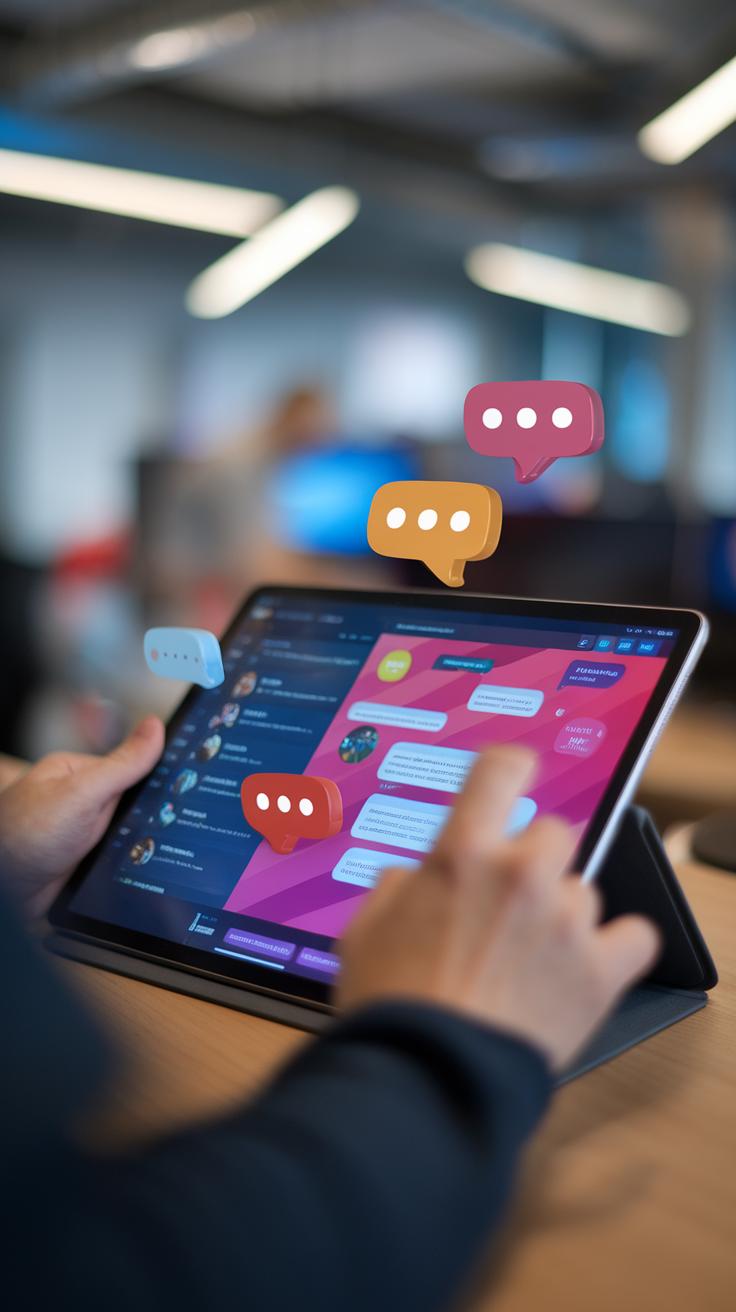Introduction
In today’s competitive business landscape, effectively engaging with customers has never been more crucial. One of the best ways to do this is through a website chat widget, which offers a real-time communication channel between businesses and their customers. However, simply having a chat feature isn’t enough; understanding and optimizing the chat interaction rate is essential for maximizing its potential. High chat interaction rates translate to increased customer satisfaction, higher conversion rates, and ultimately, growth for businesses.
This article delves into various strategies aimed at boosting chat interaction rates for free website chat widgets. From understanding the customer journey to tailoring chat experiences and leveraging data analytics, the following sections will explore actionable tactics that can be easily implemented. By adopting these strategies, companies can significantly enhance user engagement and foster lasting relationships with their customers.
Understanding Chat Interaction Rate
Chat interaction rate is an essential metric that reflects the frequency with which website visitors engage with a chat widget. Essentially, it quantifies how often potential customers utilize this communication channel, revealing their willingness to seek assistance, gather information, or resolve issues through direct communication. This rate can be calculated by dividing the number of interactions (messages exchanged between the customer and support representative) by the total number of unique visitors to the site, and multiplying that figure by 100 to express it as a percentage.
The significance of chat interaction rate for businesses cannot be overstated. A high interaction rate indicates that visitors find value in engaging through the chat feature, which often translates into higher customer satisfaction and improved conversion rates. This indicates that customers are more likely to seek help when they perceive that support is readily available, fostering a positive perception of the brand. Conversely, a low interaction rate may suggest that visitors do not see the chat option as a useful resource. This could lead to missed opportunities for engagement and conversion, ultimately hindering business performance.
The implications of high versus low interaction rates extend beyond immediate user engagement. A strong interaction rate can correlate with enhanced customer loyalty, as frequent positive interactions with a brand can lead to repeat business and word-of-mouth referrals. On the other hand, low interaction rates can signal potential issues, such as website accessibility problems, unclear messaging about the chat service, or dissatisfaction with the offerings presented, prompting customers to leave without expressing their needs.
Businesses should analyze the quality of interactions alongside the quantity. Tracking metrics such as response time, resolution rates, and customer feedback regarding their chat experience adds a layer of depth to understanding engagement. This qualitative data can be vital in refining chat strategies, allowing businesses to address any shortcomings and better meet customer expectations.
Understanding chat interaction rate is key for businesses aiming to enhance customer engagement. By recognizing its importance and implications, organizations can devise better strategies to encourage interactions, thus driving growth and fostering a stronger connection with their clientele.
Analyzing Customer Needs and Preferences Informing Chat Strategies
Understanding Customer Needs through Feedback and Behavior Analysis
To elevate chat interaction rates and foster lasting customer engagement, it is pivotal to analyze customer needs and preferences thoroughly. A comprehensive understanding of these factors enables businesses to craft chat strategies that resonate with users, ultimately driving growth. The first step in this process involves gathering customer feedback, which serves as a critical resource in tailoring chat experiences.
Establishing a feedback loop is essential. One effective method for collecting insights involves utilizing post-chat surveys. These brief questionnaires allow customers to share their thoughts on their interaction, highlighting areas for improvement and aspects that worked well. Questions can be designed to gauge satisfaction with response time, clarity of information, and overall experience. By systematically analyzing this data, businesses can identify trends that inform necessary adjustments to chat strategies.
Another robust approach is to deploy user behavior analytics tools. Tracking customer interactions with the chat widget can reveal invaluable data regarding peak interaction times, frequently asked questions, and common drop-off points. Understanding when and where customers tend to disengage helps businesses fine-tune their chat interfaces and strengthen engagement strategies. For example, if data indicates that customers often leave the chat during specific automated responses, businesses can reconsider the phrasing or content of those messages to enhance user satisfaction.
Implementing social listening strategies can further enrich understanding of customer needs. Monitoring social media channels and forums allows companies to capture real-time conversations surrounding their brand. By analyzing sentiment and common inquiries, businesses can proactively adjust their chat strategies to address prevailing customer concerns or emerging trends. This approach fosters a more agile response to customer needs, leading to enriched chat interactions.
It is also beneficial to segment customer profiles to tailor interactions uniquely for different demographics. For instance, younger customers may prefer a more casual tone, while older customers might appreciate a more formal approach. A well-rounded understanding of diverse customer preferences can lead to personalized chat experiences that resonate on a deeper level. By continuously refining these strategies based on ongoing feedback and behavior analysis, businesses can ensure that their free chat widgets deliver valuable interactions that drive customer satisfaction and growth.
Optimizing Chat Widget Design for Enhanced Chat Interaction Rate
When aiming to boost chat interaction rates through a free website chat widget, the design of that widget plays a pivotal role. An engaging and well-structured chat interface can greatly influence user experience, making it a crucial element in maximizing engagement and fostering customer loyalty. Key design aspects include placement, size, and the overall user interface, each contributing to how readily users will engage with the widget.
Placement and Visibility
Strategic placement of the chat widget on a webpage is fundamental to its visibility. Ideally, the widget should be situated in a place where users naturally look, such as the bottom right corner, which has become a convention across many platforms. This placement not only ensures the chat widget is visible without obstructing essential content but also invites user interaction. A floating widget that remains in view as users scroll can further enhance engagement, ensuring that assistance is always within reach.
Size Matters
The size of the chat widget is another influential factor. A widget that is too large can overwhelm users and detract from the rest of the site’s aesthetic. Conversely, a widget that is too small may go unnoticed. Striking a balance is key; the widget should be compact enough to fit seamlessly within the design while being large enough to draw attention. Icons and text must be easily legible to avoid frustrating users and to encourage them to initiate conversations.
User Interface: Simplicity and Approachability
The user interface (UI) of the chat widget plays a significant role in the interaction rate. A clean and intuitive layout makes it easier for users to understand how to start a chat. Incorporating friendly visuals and approachable language within the widget can create a welcoming atmosphere. For instance, using a simple greeting message or a chatbot avatar can personalize the experience, promoting a sense of connection. Additionally, ensuring the widget is compatible with mobile devices is imperative, as an increasing number of users engage from their smartphones.
Incorporating these design principles can significantly enhance the effectiveness of chat widgets, making them a powerful tool for increasing customer engagement and driving growth. A well-optimized chat widget not only attracts attention but also transforms viewers into active participants, ultimately contributing to the success of a business’s online presence.
Leveraging Proactive Engagement Techniques for Enhanced Chat Interaction Rate
Strategies for Proactive Visitor Engagement Through Chat Features
Boosting chat interaction rates hinges on the ability to engage visitors proactively. This approach involves utilizing chat features to reach out to potential customers before they take any action, thereby enhancing their overall experience and increasing the likelihood of engagement. One effective tactic is the use of automated prompts strategically timed to appear based on user behavior. These prompts can serve as gentle nudges, inviting visitors to interact or seek assistance. For example, if a user spends several moments on a product page without making a decision, an automated message could pop up, saying, “Need help choosing the right size? We’re here for you!” This targeted engagement not only captures the user’s attention but also guides them toward a resolution, ultimately improving their interaction with the chat widget.
Another powerful technique involves personalized invitations. By leveraging data such as geographical location, past interactions, or even time on site, companies can tailor their chat invitations to make them more relevant and enticing. For instance, a returning visitor could receive a message such as, “Welcome back! We missed you! Do you have questions about your last order?” This sense of personal touch fosters connection and motivates users to engage, increasing the interaction rate.
In addition to automated prompts and tailored messages, proactive engagement can also be enhanced through the use of exit-intent technology. When a user exhibits behaviors that indicate they might be leaving the site, a chat invitation can appear, offering assistance or addressing common concerns. For instance, “Before you go, can we help you find what you’re looking for?” This strategy helps capture potential lost customers, offering one last opportunity to engage them in a meaningful conversation.
Integrating interactive elements within chat conversations can significantly elevate the user experience. Features like quick reply buttons, visual product displays, or even surveys can be employed to engage users actively. By providing these interactive options, businesses not only streamline the interaction but also hold users’ attention longer, thereby increasing the chances of conversion.
Leveraging proactive engagement techniques through chat features enhances customer interaction rates. By utilizing automated prompts, personalized messages, exit-intent technology, and interactive elements, businesses can create a dynamic chat experience that resonates with users, driving growth and improving overall engagement.
Utilizing Analytics for Continuous Improvement Maximizing Chat Interaction Rate
Measuring Chat Performance Effectively
Understanding and optimizing chat interaction rates is a necessity in the quest for elevated customer engagement and business growth. Analytics plays a pivotal role in gauging the performance of chat widgets on websites, providing businesses with the data needed to make informed decisions. By measuring interaction rates, businesses can identify trends, assess user engagement, and pinpoint areas for improvement. Key performance indicators (KPIs) such as response time, conversation length, and customer satisfaction scores can offer insightful metrics that inform future strategies.
Utilizing analytics tools like Google Analytics, LiveChat, or Intercom can drastically enhance the effectiveness of chat interactions. These tools offer real-time data monitoring capabilities, allowing businesses to track user engagement metrics and evaluate whether their chat strategies are yielding desired results. By analyzing chat transcripts, organizations can discern common customer inquiries and issues, informing the development of automated responses that can streamline service and boost interaction rates.
Data-Driven Strategies for Optimization
To maximize chat interaction rates, a systematic approach to data analysis is paramount. Businesses should regularly examine their chat analytics to discern patterns and preferences among their user base. For instance, analyzing peak chat times could guide staffing decisions or reveal opportunities for proactive engagement by initiating chats when users are most active. Identifying the most common types of inquiries can lead to improving FAQ sections or enhancing training for chat agents to address recurring disputes efficiently.
A/B testing various chat prompts can help businesses understand what resonates most with their audience. By experimenting with different phrasing or visual styles in chat windows, organizations can gather data that reflects user preferences, thus refining their outreach strategies. This data-driven tactic not only enhances chat performance but also fosters deeper connections with customers as responses become increasingly tailored to their specific needs.
Incorporating user feedback into the analytical framework can also provide a clearer picture of chat efficacy. Surveys or follow-up questions post-chat can yield valuable insights regarding customer satisfaction and areas requiring refinement. By utilizing analytics in this manner, businesses can create a continuous feedback loop that aligns chat strategies with customer expectations, ensuring that interaction rates remain not only high but also meaningful.
Integrating Chat Interactions with Broader Marketing Efforts
Supporting Marketing Strategies through Chat Interactions
Chat interactions are not merely isolated transactions but can serve as vital touchpoints within a brand’s overall marketing strategy. By integrating chat widgets into broader marketing efforts, businesses can enhance the efficiency of their customer engagement processes and drive growth. The immediacy of chat allows companies to respond to customer inquiries in real-time, thus reinforcing their brand messaging and contributing to various marketing campaigns.
For instance, when seasonal promotions or product launches are underway, the chat function can significantly boost customer interaction rates by providing instant information and answering questions. This seamless communication encourages potential customers to take action, further supporting marketing strategies aimed at driving sales.
Synergies Between Chat Teams and Marketing Departments
To maximize the impact of chat interactions on marketing initiatives, fostering a collaborative environment between chat teams and marketing departments is essential. Regular meetings and cross-functional brainstorming sessions can help both teams align their goals and identify shared metrics that matter. By doing so, chat representatives can become more aware of ongoing marketing campaigns and adjust their conversational strategies to promote these efforts through targeted messages.
Chat teams can gather valuable insights about customer preferences and pain points during interactions. This feedback loop provides the marketing department with the information needed to tailor campaigns more effectively, leading to improved customer targeting and retention strategies. For instance, customer queries on specific features or services can inform new content creation, ensuring that marketing materials address the actual concerns and interests of potential clients.
Integrating chat analytics with marketing analytics can enhance this collaboration, allowing both teams to assess performance more holistically. By understanding how chat interactions influence conversion rates and customer satisfaction, companies can refine their approach to customer engagement. Utilizing shared platforms that compile data from chat interactions and marketing campaigns enables more cohesive strategy development, ultimately leading to enhanced customer engagement and growth.
Through these synergies, chat interactions become a powerful extension of marketing efforts, creating a dynamic where each team supports the other, thus maximizing overall effectiveness and driving sustained growth.
Conclusions
Increasing the chat interaction rate is not just about having a chat widget on a website; it’s about creating a seamless and impactful customer experience. By implementing strategies like proactive chat invitations, personalized interactions, and robust analytics, businesses can foster a more engaging atmosphere that encourages users to communicate. This approach not only enhances customer satisfaction but also dramatically boosts sales conversions.
As the digital world continues to evolve, staying ahead of the curve in customer interaction practices is essential. Companies that prioritize chat interaction strategies will likely see significant growth in engagement and sales. Embracing the power of chat effectively can lead businesses not just to survive the competitive landscape but to thrive in it.


















